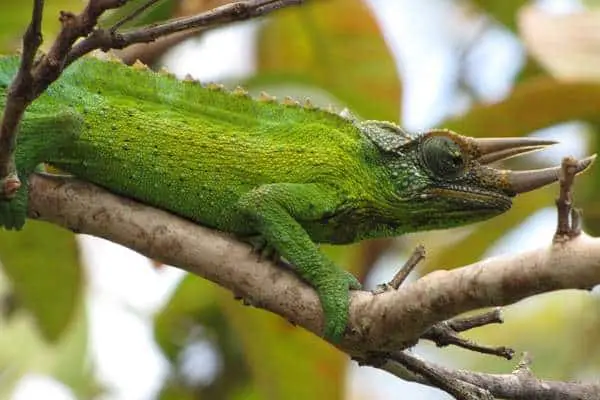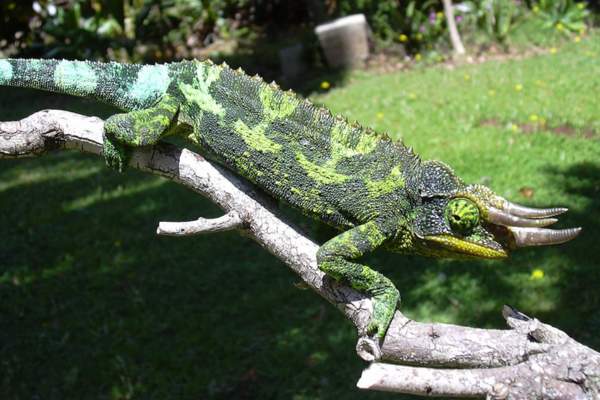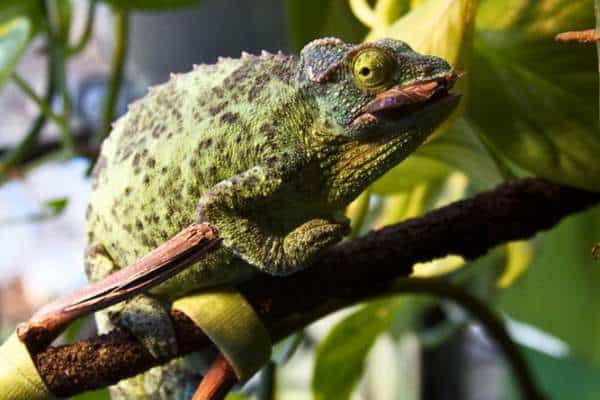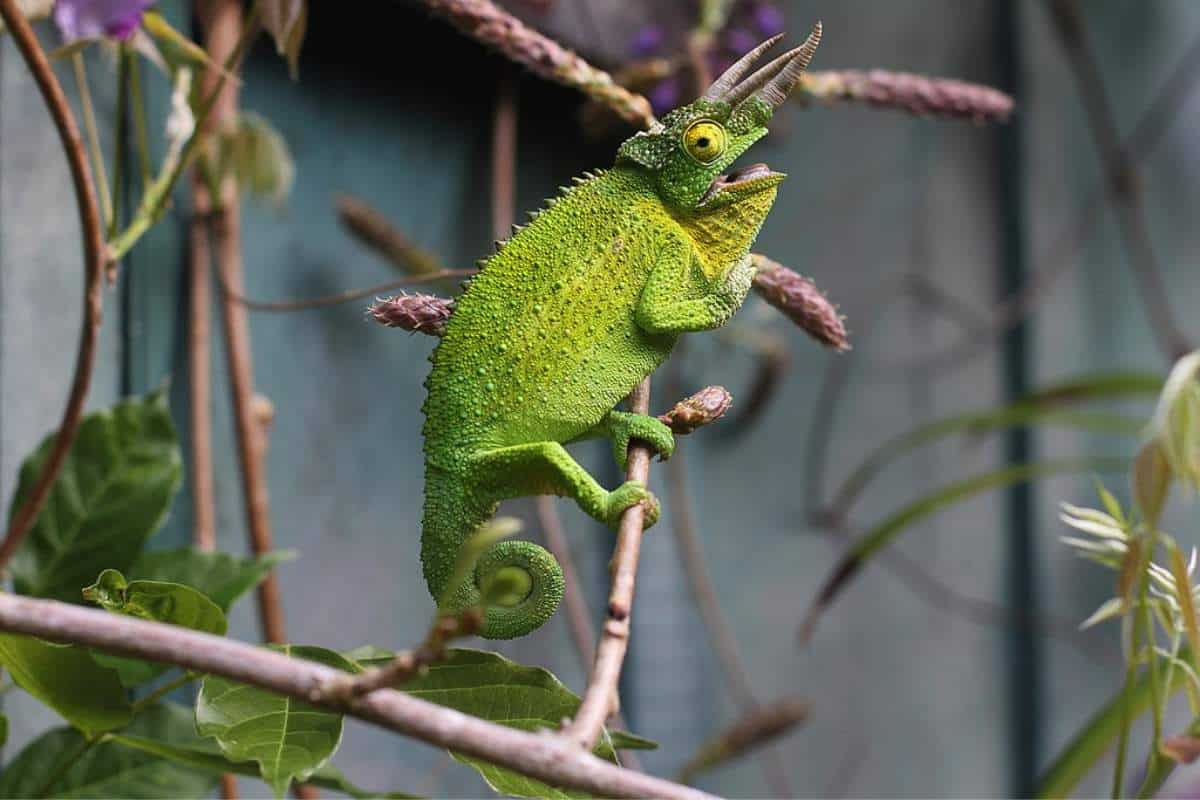The Hawaiian Islands, a tropical paradise in the Pacific Ocean, are home to a plethora of unique and fascinating wildlife. As an isolated archipelago, the islands have developed their own distinctive ecosystems, housing many endemic species. Among the diverse group of animals that call Hawaii home are several species of reptiles, including the visually captivating chameleons.
Chameleons in Hawaii

Although chameleons are not native to the Hawaiian Islands, one species, the Jackson’s chameleon (Trioceros jacksonii), has successfully established a population in the region.
The Jackson’s chameleon was first introduced to Hawaii in the 1970s, likely as a result of the pet trade. It is believed that the first Jackson’s chameleons in Hawaii were brought to the islands by a pet dealer who imported them from Kenya. Some of the chameleons escaped or were released into the wild, and they have since established populations on several of the Hawaiian islands.
The Jackson’s chameleon is now considered an invasive species in Hawaii, where it poses a threat to native ecosystems by competing with native species for resources and preying on native insects and other small animals. Efforts are underway to control their populations and prevent further spread of this non-native species.
Range and Habitat

The Jackson’s chameleon is primarily found on the Big Island of Hawaii, but populations have also been reported on Oahu, Maui, and Kauai. These chameleons inhabit a variety of environments, including forests, shrublands, and agricultural areas.
They are arboreal animals and can often be found in trees, shrubs, and bushes, where they utilize their excellent camouflage abilities to blend in with their surroundings.
On the Big Island
On the Big Island of Hawaii, chameleons are known to inhabit various areas, including forests, shrublands, and agricultural regions. While spotting these well-camouflaged creatures can be challenging, some specific locations where you may have a higher chance of seeing them include:
- Pana’ewa Rainforest Zoo and Gardens: Located in Hilo, this 12-acre zoo and botanical garden is home to several animal species, including Jackson’s chameleons. With its lush vegetation, the garden provides a suitable habitat for these arboreal reptiles.
- Akaka Falls State Park: This park, situated on the northeastern side of the Big Island, features lush tropical rainforests and two picturesque waterfalls. The dense vegetation in the park creates an ideal environment for chameleons to reside and blend in with their surroundings.
- Hawai’i Volcanoes National Park: While chameleons might not be commonly found in the park’s lava fields, they can be spotted in the rainforest areas near the Kilauea Visitor Center or along some of the park’s hiking trails with dense vegetation.
- Lava Tree State Monument: This park, located in the Puna district, contains a forested area with lava molds of tree trunks. The park’s vegetation provides suitable habitat for chameleons.
- Residential neighborhoods and gardens: Chameleons have been known to appear in residential areas, particularly those with lush gardens and plenty of vegetation. You might spot them in trees, bushes, or shrubs while walking around neighborhoods or exploring local parks.
Remember that these creatures are masters of camouflage, so spotting them may require patience and a keen eye. If you do encounter a chameleon, be sure to observe from a distance and avoid disturbing their natural habitat.
Diet

Jackson’s chameleons are insectivorous, feeding primarily on a variety of insects such as crickets, flies, and beetles. They are ambush predators, relying on their camouflage to remain hidden until prey comes within striking distance.
Using their lightning-fast, extendable tongues, chameleons can snatch insects out of the air or off nearby surfaces with remarkable precision.
Impact on Native Wildlife
While the Jackson’s chameleon is not currently listed as an endangered species, its introduction to the Hawaiian Islands has raised concerns about its impact on native ecosystems.
As predators, they have the potential to affect the populations of native insects, which could have a cascading effect on other species in the food chain.
However, studies on the chameleon’s impact on native ecosystems are limited, and more research is needed to fully understand the extent of their influence.
Common Questions About Chameleons in Hawaii
Visitors to the Hawaiian Islands may have some questions about the local chameleons, including:
Are chameleons dangerous to humans?
No, chameleons are not dangerous to humans. They are shy, non-aggressive creatures that prefer to avoid confrontation.
Where can I see chameleons in Hawaii?
It’s generally known that Jackson’s chameleons have established populations on several islands, including Oahu, Maui, and Hawaii (the Big Island). They are often found in suburban and rural areas with suitable vegetation.
You might spot chameleons in forested areas, parks, or even in some residential neighborhoods. However, they can be challenging to find due to their exceptional camouflage abilities.
Can I keep a chameleon as a pet in Hawaii?
Here are some things to consider about the regulations surrounding catching and keeping Jackson’s chameleon (Trioceros jacksonii), which has established a population in Hawaii.
Catching and keeping a Jackson’s chameleons as a pet in Hawaii is prohibited, even tough they are not native wildlife. Even though they got their start on the island as released pets back in the 1970s, you can’t take them out of the wild since they are still protected by the Hawaii Department of Agriculture.
Consider the following points before considering catching and keeping a chameleon in Hawaii:
- Understand the ethical concerns associated with capturing and keeping wild animals as pets.
- Be very gentle should you choose to handle a chameleon, in order to prevent injury or stress.
- Familiarize yourself with local laws and regulations regarding the capture and possession of chameleons.
- You can easily purchase captive bred chameleons that make great pets
Always be mindful of the potential consequences and responsibilities associated with doing disturbing wildlife of any kind. Proper respect for these unique creatures are essential to ensure their wellbeing and the preservation of local ecosystems.
Final Notes
The presence of chameleons in Hawaii is a captivating example of how introduced species can adapt and thrive in new environments. While the Jackson’s chameleon adds a touch of exotic wonder to the islands, it is essential to remember the potential impacts of introducing non-native species to delicate ecosystems.
Visitors and residents alike should be mindful of the need to preserve and protect the unique wildlife of the Hawaiian Islands.
In conclusion, the Jackson’s chameleon, though not native to Hawaii, has become an intriguing part of the local fauna. As the islands continue to be a popular tourist destination, awareness and conservation efforts will be crucial in ensuring the stability and balance of Hawaii’s fragile ecosystems.




